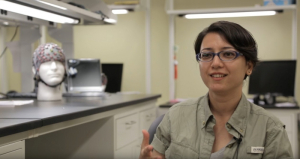Collaborative Effort Yields Parkinson’s Disease Research Findings
Ilknur Telkes, who earned a Ph.D. in biomedical engineering from the University of Houston last year and was a 2017 North American Neuromodulation Society (NANS) Junior Scientist Award winner, had an article published in the prestigious Proceedings of the National Academy of Sciences (PNAS) journal.
The article, titled “Local field potentials of subthalamic nucleus contain electrophysiological footprints of motor subtypes of Parkinson's disease,” reports the location inside the brain that correlates with two major Parkinson’s disease types – one form is characterized by tremors, while instable posture and difficulty walking characterize the other.
Parkinson’s is a complex progressive neurodegenerative disorder with a broad range of symptoms. The new findings could lead to improved patient-specific therapy.
While a doctorate student at the UH Cullen College of Engineering, Telkes spent a lot of her research time in the operating room at Baylor College of Medicine working with clinicians – Ashwin Viswanathan from BCM Neurosurgery and Joohi Jimenez-Shahed from BCM Neurology – to pinpoint areas in the brains of patients suffering from Parkinson’s disease using a novel intraoperative neural data acquisition and signal processing system developed by Nuri Ince, assistant professor of biomedical engineering at UH.
Local field potential recordings collected during deep brain stimulation surgery (using multiple microelectrodes) helped the research team capture oscillatory neural patterns in the territories of the subthalamic nucleus of the brain that are specific to these motor subtypes. This information helped the team understand how the brains of patients suffering from Parkinson’s disease worked.
“Our results indicate that the spatiospectral dynamics of the brain can be used as an objective method to distinguish these two motor subtypes of Parkinson’s disease. To our best knowledge this is the first time such a link has been reported,” said Ince, who was Telkes’ advisor at UH and a corresponding author on the PNAS paper.
“These observations might lead to the development of sensing and stimulation strategies targeting the sub-territories of the subthalamic nucleus for the personalization of deep-brain stimulation (DBS),” he added. “This could make the DBS therapy for patients more efficient.”
Other contributing authors on the paper are: Ashwin Viswanathan and Joohi Jimenez-Shahed, both with BCM; Aviva Abosch from the University of Colorado School of Medicine; Musa Ozturk, a UH biomedical engineering Ph.D. student; Akshay Gupta with the University of Minnesota Medical School; and Joseph Jankovic with BCM.
The research project was the result of a collaboration with UH as the lead institution, Baylor College of Medicine, the University of Minnesota and the University of Colorado.
Telkes is now pursuing postdoctoral work in the department of neuroscience and experimental therapeutics at Albany Med, the academic health science center in northeastern New York. Her current research interests include intraoperative and postoperative investigation of spinal cord stimulation in chronic pain as well as deep brain stimulation in Parkinson’s disease and Essential tremor.
Established in 1914, PNAS is one of the world's most-cited and comprehensive multidisciplinary scientific journals. Publishing more than 3,200 research papers annually, the journal's content spans the biological, physical, and social sciences and is global in scope.
To read the article, please click here.
